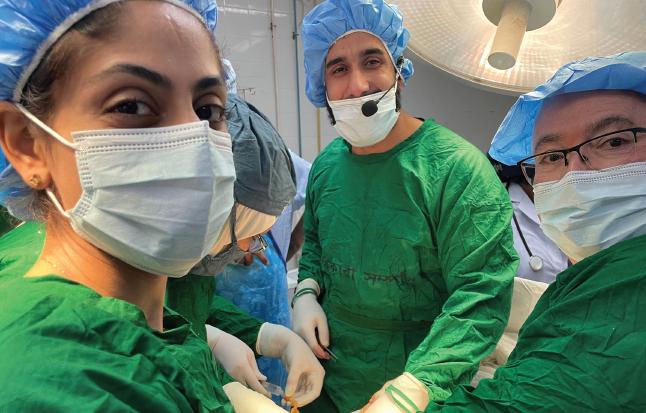While the developing world continues to optimise progressive patient outcomes, the majority of urogynaecological patients around the world are battling more rudimentary targets. A resounding disparity in healthcare literacy and the availability of medical services means that largely preventable pathology remains a significant cause of urogynaecological morbidity in under resourced settings. This paper will look at several aspects of urogynaecological healthcare from a global perspective, what can (and should be) done about it and what we think the future holds.
The most well-known urogynaecological issue on a global-health scale is that of female genital fistulae. The World Health Organization (WHO) estimates that two million women worldwide suffer from untreated genital fistulae and 100,000 new cases occur annually.1 The majority of these cases occur in the context of obstructed labour, which causes ischaemia and eventual necrosis of pelvic organs, leading to fistula formation between two epithelial surfaces. Obstetric fistulae effect the poorest, most disadvantaged women. The advent of a fistula in the absence of specialised medical care can be the start of morbid slippery slope of repercussions. In addition to the well-known symptoms of incontinence of urine and/or faeces, pain and dyspareunia, women experience social marginalisation and financial boycotting.
From an urogynaecological perspective, reconstructive pelvic surgery following genital fistula formation remains an incredibly complex aspect of clinical practice. Although the post-operative success rates of genital fistulae repairs can be high2 optimal outcomes require a highly refined surgical skill set in specialised centres. A primary prognostic factor in reconstructive surgeries for genital fistulae is the degree of fibrosis.2 The longer patients wait to present for care, the greater the degree of scarring and this makes the tissue friable and more likely to dehisce post operatively. Unfortunately, due to the taboo nature of the injury, fear of further marginalisation, vulnerability of patients and a lack of access to medical facilities, patients often time delay presentation. This complex interplay of intricate pelvic pathology occurring in significantly under resourced settings with profound social stigma both exacerbates and prolongs the plight of women with genital fistulae.
Another aspect to the cycle of genital fistulae is sexual violence to the pelvic floor. The WHO estimates that 1 out of 3 women will experience sexual or physical violence in their lifetime.3 The most common form of sexual violence is forced penetration with male genitalia but sharp objects, chemicals and even firearms are used. Perpetrators of sexual violence can often be well known to the woman, with the act being conducted in familiar settings like schools, healthcare facilities or as part of a cultural initiation. Unfortunately, sexual violence tends to be exacerbated during times of conflict and even employed as a weapon of war. An alarming trend over the past decade has been the increase in the rape of girls under the age of ten, which has increased from 3% to 6% of all treated cases at some centres.4 As expected, following sexual violence, the delay in presentation for medical care is usually further drawn out. In addition to the surgical complexities that these vulnerable women pose, they require a more holistic approach to care from a rehabilitation, social and psychological point of view.
As parts of the developing world start to prosper from an economic and social point of view, the urogynaecological challenges faced locally likewise alter. In our recent trip to Bangladesh, the rise of a more educated and financially stable middle class has meant that health literacy has increased. Thus, presenting complaints of prolapse symptoms or urinary incontinence, which were previously perceived as negligible start to come to the forefront. Thus, local surgeons are faced with a patient demand that they may be uncomfortable dealing with from a surgical skillset point of view. In addition to this, an increased knowledge of available management options (by clinicians and patients alike) leaves a void in treatment options if those services are not available. While the use of laparoscopy by gynaecologists in the developing world remains in its infancy, this comes with its own set of issues. There has been a rise in iatrogenic female genital fistulae which are usually higher in the pelvis (involving ureters) and can be more difficult to manage. In some centres, iatrogenic fistulae are now starting to account for nearly 40% of all cases.5

While the global picture of urogynaecology may seem like a story of resounding doom and gloom, there are certainly positive facets looking to the future. While a solid legal framework is part of the picture, the issue extends much deeper and needs to be addressed at its core. Predominantly, this comes down to empowering women towards primary prevention. A change of culture can be instigated through increased access for women to education and healthcare. As a team we have successfully undertaken urogynaecology capacity building over the last two decades in the Pacific and Sub- Continent. Our model is to teach and mentor local doctors in pelvic anatomy, patient assessment (and selection), surgical management and follow up. To date we have managed to mentor 42 consultants in the Pacific through regular visits and close follow up of surgical outcomes. These gynaecologists have then gone on to practice in some of the most remote places on Earth (like Kiribati and Tuvalu). We have managed to liaise with local teams and form specialised centres that aim to provide holistic urogynaecology care. We provide lectures to doctors (from residents to consultants) as well as midwives and physiotherapists. Over time, this has led to the development of proficient urogynaecological teams, who can appropriately assess patients, safely operate while knowing their limitations, manage complications and follow up patients. In addition to this, we provide surgical equipment and follow-up channels for the pre-operative multi-disciplinary discussion of difficult cases. This has been achieved with simple WhatsApp groups where cases are discussed and combined opinions formulated towards optimising patient care.
As a further means of secondary prevention, the Federation of International Gynaecologists and Obstetricians (FIGO) fistula surgery training initiative has made great inroads towards the WHO goal of eradicating obstetrics fistulae by 2030. FIGO developed a structured curriculum for the training of fistula surgeons. The program thus far has facilitated for the administration of appropriate equipment, facilities and trained personnel to some of the most vulnerable women on earth. This initiative has provided life-restoring treatment and dignity to over 6000 women thus far.6 Since this article has been published, that number has now reached a staggering 18,000 women.
The final step towards addressing this inequality of urogynaecological care across the globe, as with any interventional measure, is raising awareness. The disempowerment of women remains a contentious and somewhat taboo topic despite it affecting millions of vulnerable women worldwide. Through a sustained effort of highlighting inequalities and the promotion of safe interventional holistic care, things can (and will) slowly but surely change. If you would like to get involved or donate towards our efforts, please visit https://flourishingwomen. com.au/
References
- World Health Organization. Obstetric fistulas. 2018. Available from: https://www.who.int/news-room/facts-in-pictures/ detail/10-facts-on-obstetric-fistula
- Maroyi R, Shahid U, Vangaveti V, et al. Obstetric vesico-vaginal!stulas: midvaginal and juxtacervical !stula repair outcomes in the Democratic Republic of Congo. Int J Gynaecol Obstet. 2021;153(2):294–299. https://doi.org/10.1002/ijgo.13472.
- UNHCR policy on the prevention of, risk mitigation and response to gender-based violence. United Nations High Commissioner for Refugees https://www.unhcr.org/5 fa018914/unhcr policyprevention- risk-mitigation-response-gender-based-violence; 2020.
- Mukwege D, Berg M. A holistic, person-centred care model for victims of sexual violence in democratic republic of Congo: the Panzi hospital one-stop centre model of care. PLoS Med. 2016;13(10), e1002156.
- Majinge, P., Sie-benkotten-Branca, V. and Daffeh, B. Aetiology of Vesico Vaginal Fistula (VVF)—Observation in Patients Managed at CCBRT(Comprehensive Community Based Reha bilitation in Tanzania) Hospital, Dar esSalaam, Tanzania. January to March 2016.Open Journal of Obstetrics and Gynecology. 2017;7,649- 677. https://doi.org/10.4236/ojog.2017.76067
- Slinger G, Trautvetter L, Browning A, et al. Out of the shadows and 6000 reasons to celebrate: an update from FIGO’s !stula surgery training initiative. Int J Gynaecol Obstet. 2018;141(3):280– 283. https://doi.org/10.1002/ijgo.12482.







Leave a Reply